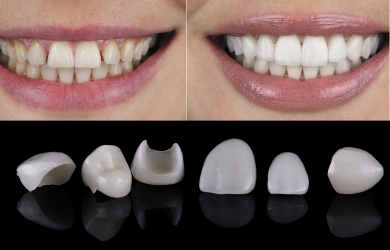Tooth laminates and dental veneers are popular dental treatments preferred to have a beautiful and aesthetic smile. Although laminates and veneers have the same function, there are fine details to consider in both procedures. Before making a decision, it is necessary to know the advantages, pros and cons of laminates and veneers.

Dental laminates and veneers give you a bright white, vibrant and aesthetic smile. The main difference between them is their materials and features.
Dental laminates are a treatment method that is applied by covering the front surface of the teeth like a hat and applying minimal abrasion to the tooth. Laminate veneers are very similar to the appearance of natural teeth with their translucent structure and are used in the front teeth.
Dental veneers can also be applied to a single tooth or multiple teeth, they are thin pieces of material glued to the front surface of the teeth. However, they are made of porcelain or ceramic and cannot be removed after being attached to the tooth.
What is the Dental Laminate?
Dental laminate are formed by minimally processing the visible front surface of the tooth between 0.3 mm and 0.7 mm and bonding the laminates to each other with special adhesives.
Laminates are very similar to natural teeth with their translucent structure and are used on front teeth. Laminates are an ideal option for people who want a natural-looking, less invasive treatment.Laminates are an ideal option for people who want a natural-looking, less invasive treatment.
It is an advanced type of porcelain and is an affordable way to improve the appearance of your teeth. The biggest advantage of dental laminates is that they can be removed when you decide you no longer want them.
With laminate and veneers, you can have the smile aesthetics called Hollywood smile preferred by celebrities in a very short time.
Advantages and Disadvantages of Dental Laminates
- Since laminates offer a smooth surface, they do not change color and do not stain. You can easily consume beverages such as tea and coffee.
- There is no need to reshape your natural teeth during the application, there is very little enamel loss.
- It has a light permeability that does not resemble the natural tooth structure.
- It is easy to get used to and use since it is applied only to the front surfaces of the teeth.
- It prevents the formation of tartar and dental plaque.
- They can hide damages such as breakage, cracking or abrasion in the teeth.
- They are useful in eliminating deformities in the teeth and correcting crooked or irregular teeth.
- Laminates are cheaper than veneers and the treatment can be completed in just one session. Additionally, laminates do not require any special care or maintenance after they are bonded to your teeth.
However, dental laminates also have some disadvantages.;
Laminates may not be as durable as veneers. In addition, since laminates are only applied to the front teeth, the application area is not as wide as veneers.
Patients should avoid hard foods that will damage their teeth. They are not suitable for people with weak teeth or gum disease.
What are the Dental Veneers?
Veneers are a fast and effective treatment method for broken, stained, deformed or crooked teeth, usually made of porcelain or resin composite, which are bonded to the front surface of the tooth.
It mimics the size, shape and color of the natural appearance of the teeth, giving a natural appearance.
Advantages and Disadvantages of Dental Veneers
- Veneers are more durable than laminae and their use is long-lasting.
- They can be applied not only to the front teeth but also to the back teeth.
- They are particularly suitable for the treatment of broken, cracked and irregular teeth.
Disadvantages of Dental Veneers;
The big disadvantage of veneers is that they are irreversible. If you do not like your veneers after having them fitted, you will have to damage the underlying teeth to remove them again. Therefore, you may have to use them
They tend to be more expensive than laminate. They are more invasive than laminates, meaning more intervention is required on the tooth enamel.
What are the Differences Between Tooth Laminate and Dental Veneer?
Laminates and veneers have their own unique features. A detailed comparison of the differences between dental veneers and veneers, covering key topics such as material, appearance, application process, cost, durability and suitability for various dental problems;
Price
Dental laminates are more affordable than veneers.
Veneers, especially emax (the most expensive) and zirconium veneers, are the most expensive because of their durability. Composite veneers are the most affordable type of veneers because composite materials are more economical than porcelain.
Material
Laminates, laminates made of thin porcelain, offer a natural, glass-like appearance.
Dental veneers are made of two different materials: porcelain and composite. Emax veneers are made of lithium disilicate ceramic, zirconium veneers are biocompatible and are obtained through a series of processes in a laboratory environment. Composite veneers are made of tooth-colored resin-based materials and can be applied directly to the tooth and treated in a single session
Treatment Time
Since the application of laminates requires only a small amount of shaping of the front surface of the tooth, it requires less preparation time and can be completed in one or two appointments.
In veneers, work is done from all visible aspects of the tooth at 360 degrees and therefore requires a longer time. However, composite veneers can also be applied in a single session.
Aesthetic Appearance

Since laminates are translucent, they provide a subtle enhancement by closely imitating natural enamel. Since laminate teeth have the most natural appearance, they integrate perfectly with natural teeth in the mouth.
Veneers are especially suitable for those who want to address various dental issues such as alignment, shape or serious color changes. Especially emax and zirconium provide a natural appearance since they have light permeability like natural teeth, but laminates are the best in terms of aesthetics.
Thickness
Laminates are extremely thin and usually around 0.3 mm, laminates require minimal or no enamel removal, making them the preferred choice.
Veneers are slightly thicker than laminates, especially emax coatings can require 0.3 - 0.5 mm, while zirconium can require up to 0.7 mm to 1 mm of wear. From this point of view, it requires reshaping the enamel to provide a smooth fit.
Durability (Lifespan)
Laminates can last about 5 to 10 years with proper care, but they are less durable than veneers and can be prone to breakage because they are thin.
Emax veneers can last an average of 15-20 years with proper care, and are 20% longer than zirconium Emax veneers, which can make them the preferred choice. Composite resin veneers have a shorter lifespan, usually around 5 years.
Maintenance
Laminates require daily brushing, flossing and routine dental check-ups like natural teeth. They require more delicate and detailed care to prevent cracking.
Veneers, Emax and Zirconium veneers are stain resistant and require routine oral hygiene care. Composite veneers are more prone to discoloration and require more frequent maintenance.
Suitability for Dental Problems
Laminates are best for minor problems such as slight discoloration or slight irregularities.
Veneers are more suitable for more significant and extensive dental treatments such as gaps, misalignment or severe discoloration, broken or cracked teeth.
E-max dental veneers are a type of ceramic material that offers aesthetic and natural-looking restorations. For this reason, it provides a natural translucency in tooth color and provides an appearance very similar to natural teeth even under strong light.
Zirconium veneers are also much more suitable for back teeth, as zirconium teeth are much stronger than other porcelain veneers in terms of durability.
Choosing the Right Option for Your Smile
Dental laminates and veneers each have their own unique benefits. If you are looking for a cost-effective cosmetic treatment that requires less work on your teeth and is replaceable, laminates may be ideal. For more durable, long-lasting results, veneers offer long-term aesthetic improvements.
The decision ultimately comes down to the needs of patient and expectations, as well as what is more suitable in terms of cost and other considerations.
Dental laminates and veneers are great options for a perfect smile. Before and after photos of our patients in our clinic can help you get an idea. Contact our Acardent Turkey Dental Clinic to find out if you are a candidate and which option would be best for you.
